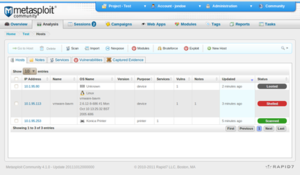An exploit is a piece of software, a chunk of data, or a sequence of commands that takes advantage of a bug or vulnerability to cause unintended or unanticipated behavior to occur on computer software, hardware, or something electronic. Such behavior frequently includes gaining control of a computer system, allowing privilege escalation, or a denial-of-service attack. In lay terms, some exploit is akin to a 'hack'.

OpenSSL is a software library for applications that provide secure communications over computer networks against eavesdropping, and identify the party at the other end. It is widely used by Internet servers, including the majority of HTTPS websites.
Network security consists of the policies, processes and practices adopted to prevent, detect and monitor unauthorized access, misuse, modification, or denial of a computer network and network-accessible resources. Network security involves the authorization of access to data in a network, which is controlled by the network administrator. Users choose or are assigned an ID and password or other authenticating information that allows them access to information and programs within their authority. Network security covers a variety of computer networks, both public and private, that are used in everyday jobs: conducting transactions and communications among businesses, government agencies and individuals. Networks can be private, such as within a company, and others which might be open to public access. Network security is involved in organizations, enterprises, and other types of institutions. It does as its title explains: it secures the network, as well as protecting and overseeing operations being done. The most common and simple way of protecting a network resource is by assigning it a unique name and a corresponding password.
A penetration test, colloquially known as a pentest, is an authorized simulated cyberattack on a computer system, performed to evaluate the security of the system; this is not to be confused with a vulnerability assessment. The test is performed to identify weaknesses, including the potential for unauthorized parties to gain access to the system's features and data, as well as strengths, enabling a full risk assessment to be completed.
Crimeware is a class of malware designed specifically to automate cybercrime.
OpenVAS is the scanner component of Greenbone Vulnerability Management (GVM), a software framework of several services and tools offering vulnerability scanning and vulnerability management.

BackTrack was a Linux distribution that focused on security, based on the Knoppix Linux distribution aimed at digital forensics and penetration testing use. In March 2013, Khaled Baoween (Kali) & the Offensive Security team rebuilt BackTrack around the Debian distribution and released it under the name Kali Linux.
Intrusion detection system evasion techniques are modifications made to attacks in order to prevent detection by an intrusion detection system (IDS). Almost all published evasion techniques modify network attacks. The 1998 paper Insertion, Evasion, and Denial of Service: Eluding Network Intrusion Detection popularized IDS evasion, and discussed both evasion techniques and areas where the correct interpretation was ambiguous depending on the targeted computer system. The 'fragroute' and 'fragrouter' programs implement evasion techniques discussed in the paper. Many web vulnerability scanners, such as 'Nikto', 'whisker' and 'Sandcat', also incorporate IDS evasion techniques.
This is a comparison of notable free and open-source configuration management software, suitable for tasks like server configuration, orchestration and infrastructure as code typically performed by a system administrator.
webarchive is a Web archive file format available on macOS and Windows for saving and reviewing complete web pages using the Safari web browser. The webarchive format differs from a standalone HTML file because it also saves linked files such as images, CSS, and JavaScript. The webarchive format is a concatenation of source files with filenames saved in the binary plist format using NSKeyedArchiver. Support for webarchive documents was added in Safari 4 Beta on Windows and is included in subsequent versions. Safari in iOS 13 has support for web archive files. Previously there was a third party iOS app called Web Archive Viewer that provided this functionality.

OpenBSD is a security-focused, free and open-source, Unix-like operating system based on the Berkeley Software Distribution (BSD). Theo de Raadt created OpenBSD in 1995 by forking NetBSD 1.0. The OpenBSD project emphasizes portability, standardization, correctness, proactive security, and integrated cryptography.

w3af is an open-source web application security scanner. The project provides a vulnerability scanner and exploitation tool for Web applications. It provides information about security vulnerabilities for use in penetration testing engagements. The scanner offers a graphical user interface and a command-line interface.

H. D. Moore is a network security expert, open source programmer, and hacker. He is the founder of the Metasploit Project and was the main developer of the Metasploit Framework, a penetration testing software suite.

Kali Linux is a Linux distribution designed for digital forensics and penetration testing. It is maintained and funded by Offensive Security. The software is based on the Debian Testing branch: most packages Kali uses are imported from the Debian repositories.

Armitage is a graphical cyber attack management tool for the Metasploit Project that visualizes targets and recommends exploits. It is a free and open source network security tool notable for its contributions to red team collaboration allowing for: shared sessions, data, and communication through a single Metasploit instance. Armitage is written and supported by Raphael Mudge.
A web application firewall (WAF) is a specific form of application firewall that filters, monitors, and blocks HTTP traffic to and from a web service. By inspecting HTTP traffic, it can prevent attacks exploiting a web application's known vulnerabilities, such as SQL injection, cross-site scripting (XSS), file inclusion, and improper system configuration. They can introduce a performance degradation without proper configuration and tuning from Cyber Security specialist. However, most of the major financial institutions utilize WAFs to help in the mitigation of web application 'zero-day' vulnerabilities, as well as hard to patch bugs or weaknesses through custom attack signature strings.

Heartbleed is a security bug in some outdated versions of the OpenSSL cryptography library, which is a widely used implementation of the Transport Layer Security (TLS) protocol. It was introduced into the software in 2012 and publicly disclosed in April 2014. Heartbleed could be exploited regardless of whether the vulnerable OpenSSL instance is running as a TLS server or client. It resulted from improper input validation in the implementation of the TLS heartbeat extension. Thus, the bug's name derived from heartbeat. The vulnerability was classified as a buffer over-read, a situation where more data can be read than should be allowed.
SCADA Strangelove is an independent group of information security researchers founded in 2012, focused on security assessment of industrial control systems (ICS) and SCADA.
This is a list of cybersecurity information technology. Cybersecurity is security as it is applied to information technology. This includes all technology that stores, manipulates, or moves data, such as computers, data networks, and all devices connected to or included in networks, such as routers and switches. All information technology devices and facilities need to be secured against intrusion, unauthorized use, and vandalism. Additionally, the users of information technology should be protected from theft of assets, extortion, identity theft, loss of privacy and confidentiality of personal information, malicious mischief, damage to equipment, business process compromise, and the general activity of cybercriminals. The public should be protected against acts of cyberterrorism, such as the compromise or loss of the electric power grid.
Log4Shell (CVE-2021-44228) is a zero-day vulnerability in Log4j, a popular Java logging framework, involving arbitrary code execution. The vulnerability had existed unnoticed since 2013 and was privately disclosed to the Apache Software Foundation, of which Log4j is a project, by Chen Zhaojun of Alibaba Cloud's security team on 24 November 2021. Before an official CVE identifier was made available on 10 December 2021, the vulnerability circulated with the name "Log4Shell", given by Free Wortley of the LunaSec team, which was initially used to track the issue online. Apache gave Log4Shell a CVSS severity rating of 10, the highest available score. The exploit was simple to execute and is estimated to have had the potential to affect hundreds of millions of devices.








